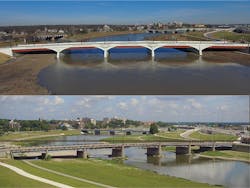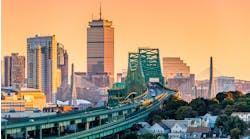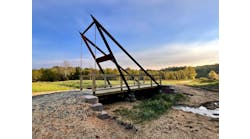The new Third Street Bridge in Dayton, Ohio tells an extraordinary and unique story about the city and its people.
Beyond the pressing functional need to replace the original structure, this massive, 700-ft-long bridge construction project was conceived, designed, and formed to both figuratively and literally bridge two communities in Dayton that have historically been cleaved by racial and economic disparities.
“People are driving slow and smiling,” Montgomery County Commission President Judy Dodge said about the new bridge. “It’s just going to open up so much on the west side. And you know, we’ve just had that division for so long.”
The original bridge was built in 1904 and underwent a major structural rehabilitation 45 years later. Since then, it required emergency repairs in 2010 and 2011 and was eventually selected for reconstruction in 2014. Local Major Bridge allocations from federal funding accounted for 89% of the project budget, as well as generous assistance coming from the Miami Valley Regional Planning Commission, the Ohio Public Works Commissioner, and the Montgomery County Engineer’s Office itself. Paul Gruner, Montgomery County Engineer, was instrumental in the design management and oversight of this $17 million bridge, the most expensive bridge project in Montgomery County history.
The new bridge addresses all previous structural deficiencies and widens the bridge with an added travel lane. It also creates safe pedestrian access via illuminated and expanded sidewalks, vistas, areas of respite, and pathways traveling across the bridge deck, below the bridge, and along the hike and bike path. Graceful lines and an Italian Renaissance inspired architectural style are prominent in the updated bridge, as seen in the large bracket-like pier design and balustrade, paying homage to the design of the historic structure. This architectural style is also commonly seen in buildings throughout the city of Dayton.
LED light fixtures at each of the pier walls create a stunning and dramatic nighttime experience for pedestrians, vehicular traffic, and commuters by boat. The lights are dynamic and color-changing, making it easy to program for special events and holidays. This upgraded structure now carries 15,000 vehicles per day, a nearly 30% increase from its original capacity. The removal of the old bridge, Dayton’s last major river-crossing bridge on shallow foundations, marks the removal of a structure seen for a long time by the community as a barrierThe community outreach initiatives conducted by the transportation aesthetic design firm Creative Design Resolutions Inc. (CDR)—along with its owner and art director, Steven Weitzman—benefited this project greatly. Montgomery County brought CDR on board in 2014 to handle the public involvement and context-sensitive aesthetic design solutions for the Third Street Bridge. Part of what made the design of this structure a controversial topic for locals is the fact that it crosses the Great Miami River, physically and metaphorically bridging the east and west sides of Dayton, which have been historically divided both racially and economically.
Given the cultural significance and high visibility of this project, Weitzman and CDR engaged many agency stakeholders and local organizations throughout the design process. They each brought their own unique point of view and investment to the project, including the President of NAACP’s Dayton Unit, Dr. Derrick Forward. This inclusive process helped ensure that the design of the structure would reflect the context of the place, respect the history of its communities, and speak to their visions for the future. Dr. Jack Marchbanks, Director of the Ohio Department of Transportation, expressed his appreciation for the way leaders from organizations and the community worked together on this project.
However, part of the challenge CDR faced as the aesthetic designers for this project was determining how best to reconcile a diverse range of visions into one unified design that would become a source of pride to both the project stakeholders as well as the larger Dayton community. In addition to the numerous Aesthetic Stakeholder Committee meetings, CDR led three public involvement meetings between 2014 and 2016 that invited public citizens to discuss and distill design possibilities, ensuring everyone’s voices were heard. Interestingly, the citizens who showed up to the public meetings were mostly from West Dayton, a community that has a Black majority. .
Concerns were voiced about the bridge being designed by an out-of-state aesthetic design firm. To some, this choice seemed to ignore the complicated and, at times, strained community relationships within the city. CDR’s community liaisons listened to and addressed those concerns by declaring their commitment to privilege the voices and visions of those members of the community and local stakeholders, working collaboratively with everyone who wished to participate in the conceptual design exploration of this monumental bridge.
At this point, many members of the community seemed more than ready and willing to share their stories and invaluable knowledge of Dayton’s unique history, culture, and community values. For instance, during these meetings, CDR learned that locals had nicknamed this bridge the “Peace Bridge” and that it carries special meaning to the Dayton community, which annually closes it off to traffic to march across it in commemoration of the 1965 Selma March led by Dr. Martin Luther King Jr. People expressed their hopes that the aesthetic design of the reconstructed bridge would be a powerful symbol for peace and reconciliation, to begin healing their divided city.
“We know we cannot remove the scars of the past, but we can heal,” said Marchbanks. “This bridge shows that people are now thinking about all the communities.”
Citizens also highlighted the significance of Paul Laurence Dunbar to their community, who was a local, Black poet laureate. Dunbar was good friends with schoolmates Orville and Wilbur Wright, commonly known as the Wright Brothers, whose bike repair shop had been located on the west side of the city since 1892, and marks the spot where the field of aviation was pioneered. Considering all of this poignant information from various neighborhood organizations, councils, and community members, it quickly became clear that the new design would need to transform this bridge into a signature landmark for the city of Dayton.
CDR’s aesthetic enhancements on the abutment walls below the bridge and pedestrian access ramps include sculptural relief portraits of Dunbar, the Wright Brothers, and their Wright B Flyer aircraft, as well as excerpts from Dunbar’s famous poem, “Sympathy.” A sculptural relief of the Selma March is also featured on the bridge pier walls along with an inspiring quotation from King.
Four overlooks are built along the pedestrian sidewalk of the bridge for commuters to rest and take in spectacular views of the city. Two informational entablatures are stationed at each of the overlooks displaying historical information about the city, the Civil Rights Movement in Dayton, the women who shaped Dayton’s history, the Tuskegee Airmen, Paul Laurence Dunbar, the Wright Brothers, Dayton’s MLK Day celebrations, and the history of funk music in Dayton. QR codes are placed next to each entablature which can be scanned using a smartphone for those curious to learn more about any of these subjects.
African Adinkra symbols of hope and unity are stamped along the sidewalk on the bridge deck. This aesthetic component was contributed by Professor Willis “Bing” Davis, who worked with CDR on the project’s aesthetic design. Davis, who currently serves as the President of the Board of Directors for the National Conference of Artists, is also an internationally known ceramic and graphic artist, as well as a professor of art, based in Dayton. He brought to this collaboration his distinct perspective on the project’s representations of history and culture within Dayton’s Black community.
“These are some of the symbols I use in my artwork, that deal with celebrating ancestors,” Davis said. “This symbol here is a nod to reconciliation, hope, and what it means is a symbol of reconciliation, peacemaking, and pacification.” And while these details in the bridge enhancements are rich in meaning and relevance, Davis said that “the bridge itself can be a piece of art,” and he hopes that the project will be “a lasting symbol of hope” for everyone in the city of Dayton to appreciate.
“This bridge and its lovely artwork will be a focal point for Dayton and Montgomery County,” Dodge said, proudly.
For reasons of safety and practicality, the bridge was closed to traffic for nearly two years while under construction. This was also true for the two hiking/biking trails that pass by the bridge, the Great Miami River Recreational Trails and the Robert Drive Pedestrian Path. Detours were provided for vehicular, bicycle, and pedestrian traffic during the construction of this monumental project. Boat traffic below the bridge was maintained, however, for most of the construction, and the contractors did an excellent job managing refuse and preventing it from polluting the waters. Construction began in November 2019 and remained on-time and within budget through October 2021.
The new Third Street Bridge has already been touted as one of the most significant expressions of context-driven and community-based aesthetics incorporated into transportation infrastructure. With its recent dedication, the beautiful city of Dayton is beginning to heal, restoring its infrastructure with symbolic hope for the future and setting a powerful example for the nation and for the world.
Davis believes “when people visit here from out of town, this is where you’ll want to take them. It’s going to do the bridging that we need to have done in terms of bringing our community together.”
Gruner reflected that “the design will unite West Dayton and downtown, and contribute to all the development that’s going on.” He added that Montgomery County “couldn’t have done a project like this without the federal money. So that’s a little plug for the infrastructure bill, too, because we need more of that kind of money to do these kinds of projects.”
Third Street Bridge recently garnered the 2021 ABCD “All Ohio” Outstanding Bridge Award for Outstanding Short Span Roadway Bridge.



